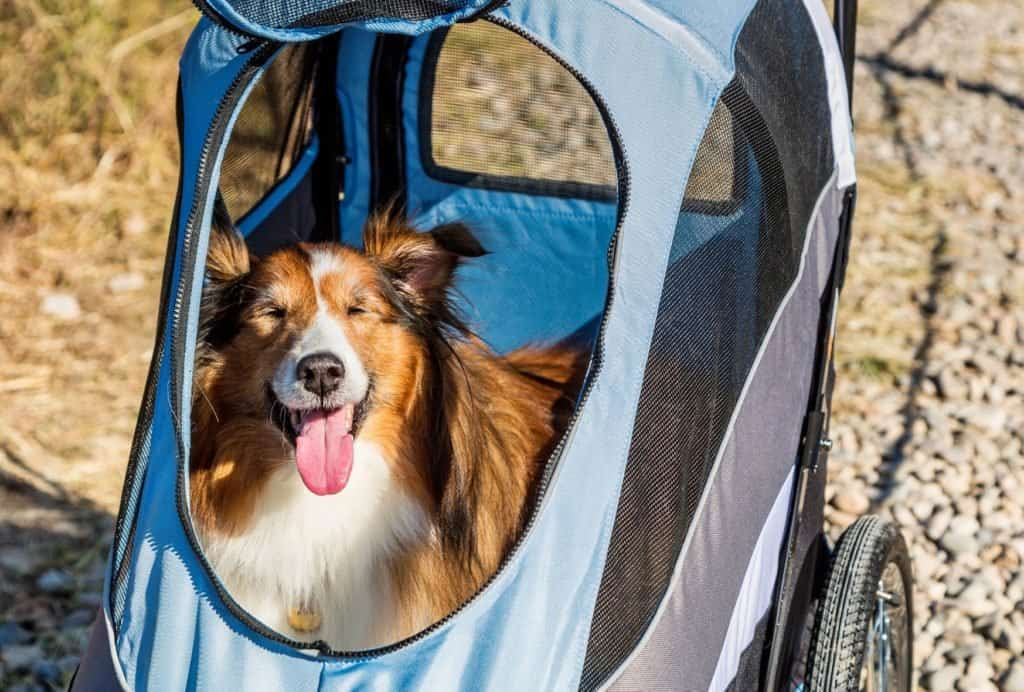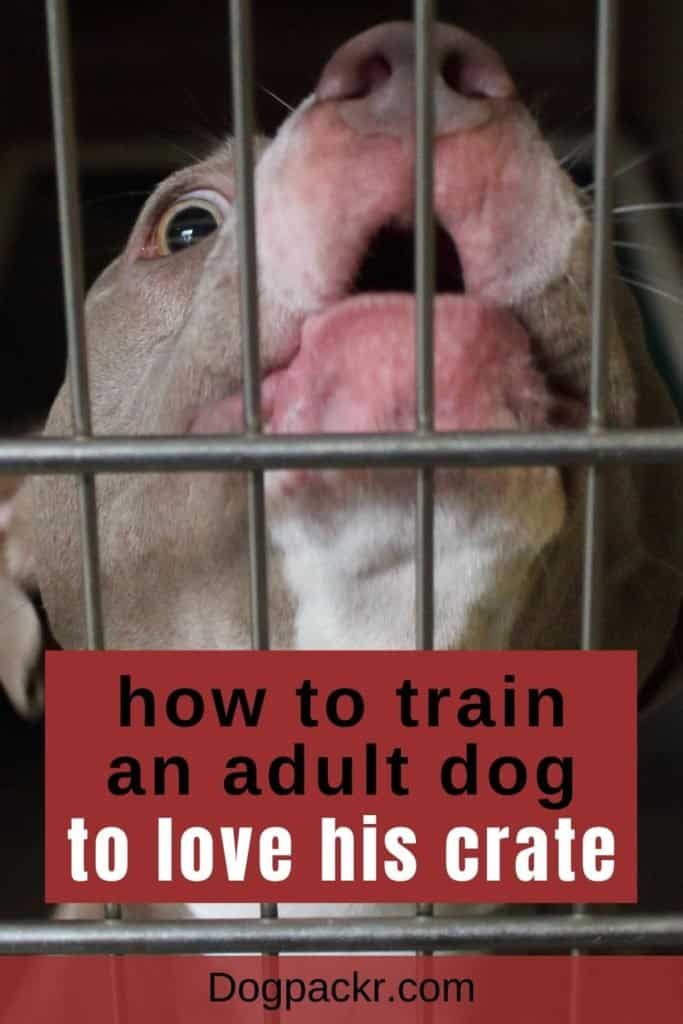
Can you crate train an older dog? I mean, is that even possible?
Many new dog parents who adopted an adult dog are probably asking this exact question.
No matter the reason, having a dog who loves his crate is generally very useful! My 4-yo Miniature Poodle Baloo was pretty hyper for the first 3 years of his life. He’s only recently calmed down a bit.
Had I gotten him later than as a puppy, I would have definitely have to crate train him!
Now, you’ll be happy to hear that crate training an adult dog is absolutely possible! In fact, it’s not that much different from crate training a puppy. You might need a little more patience. But I’ve heard of dog parents who crate trained their adult dog in 1.5 weeks!
So, in this article you’ll learn how to crate train an older dog, step by step.
Table of Contents
Can You Crate Train an Older Dog?
As the age-old saying asks—can you teach an old dog new tricks? It seems silly to ask the question now, since it’s been proven time and time again that you can, in fact, teach your old dog a new trick.
So, the short answer is yes, you can crate train your older dog. But let’s get into some specifics.
Is It Ever Too Late to Crate Train a Dog?
No, it’s never too late!
While it’s usually easier to crate train earlier in life, an old dog can still learn. It might just take a little more repetition and patience from you.
The main obstacle is going to be habit. Your dog has formed a habit of roaming the house when you’re gone, sitting in certain places and being allowed to go where he pleases.
Just like it’s hard for us to break our habits, it might be challenging to break your dog’s old habits and introduce a new one. But that only means a little extra work, not that it’s impossible!
Is Crate Training an Older Dog Different from Crate Training a Puppy?
Maybe you’ve thought that crate training an older dog is surely going to be different from crate training a puppy. You might have been gearing yourself up for a whole new set of steps for your older dog.
But you’ll be relieved to hear that the steps are essentially the same as crate training a puppy!
Again, the main thing is most likely going to be patience. Not every dog is the same, and some may take to crate training faster than others.
But be ready to put in the work for your dog!

How to Crate Train an Older Dog
Luckily, crate training an older dog is essentially the same as training a puppy.
The reasons why you might want to crate train an older dog can also be the same as for puppies. If you’re adopting an adult dog, he might still need to be potty trained. Or if your old dog is suddenly hyperactive, a crate can help with that too.
We’ll go over some of the steps briefly today.
For a more in-depth guide on crate training a dog, check out our other article on this topic. Also make sure to check out the I’ve actually written a full article about the 6 best dog crates. Make sure to check it out to get a more sophisticated overview. to find one that fits your dog’s needs.

1. Set Up the Crate and Let Him Explore It
The very first thing you’ll need to do is set up the crate. You’ll want to put it somewhere where there’s heavy traffic in your home, at least at first. This way your dog will still get to feel like part of the action, and it will lessen his separation anxiety.
When you’re purchasing your dog’s new crate, make sure that it’s big enough that your dog can stand up and turn around, but not much bigger than that. A dog’s den instinct encourages him to seek out small spaces to feel safe and calm.
Your dog will probably be curious about the crate, so let him take a look.
Reward him for checking it out. The crate should be a positive space, and you also want to encourage his curiosity about it.

2. Use High Value Treats to Reward Him
Since crate training can be challenging, especially for older dogs, use his favorite treats to reward him.
Using high value rewards will help him learn to enjoy his crate and associate with positive things faster.
As your dog gets used to the crate and starts going inside, reward him with the treats. If he’s hesitant about going in, you can throw some treats inside to encourage him.
3. Feed Him His Meals Inside the Crate
Not only does feeding your dog inside his crate encourage him to associate his crate with positive things, it also creates a routine.
Routine will be very important during the training process, and will make it much easier.
Now when you start saying “It’s dinner time,” your dog will know to go in his crate to eat his food. Plus, what dog doesn’t love his mealtimes? He’ll be excited to go into his crate!
One part of how I got Baloo from being to super hyper to a calm cutie was to set up routines.
To learn more, make sure to get my free guide for a calm dog!
4. Slowly Extend the Time the Crate Door Is Closed
When your dog starts getting comfortable in his crate, you can try shutting the door. At first, you should close it only for a second or two, and then open it and reward him.
If he’s staying calm while the crate is closed, try closing it for a little longer. Graduate to five seconds, then ten, then thirty, and so on. Every time you open the door, reward him for being calm and quiet.
As you extend the time the door is closed, just make sure your dog isn’t freaking out about it. If he’s fine with 5 seconds but not 10, don’t go up to 15.
Spend some time around the 10 second mark, until he’s settled down and is able to be in his crate calmly for that amount of time. Then you can increase the time his door is closed.
Go at your dog’s own pace here. If it feels like it’s slow going, that’s okay. You want your dog to love his crate, and locking him in when he’s panicking won’t help that!
5. Only Reward and Open the Crate When He’s Quiet
Opening the door and letting him out only when he’s quiet is the best way to teach your dog that whining and barking isn’t the way to get out.
If your dog is barking or whining, wait until your dog is silent for a few seconds. Then you can let him out and reward him.
This way, he’ll learn that he can’t bark and cry his way out of the crate. He’ll learn that he needs to be quiet and calm to be let out.

6. Slowly Go Out of Sight of the Crate
Getting your dog into his crate is one thing, but getting him to stay in there calmly without being able to see you is another.
When he’s comfortable in his crate with the door closed for long periods of time, take a step away. If he’s calm, let him out and reward him.
Just like increasing the amount of time the door is closed, slowly increase your distance from the crate.
Reward your dog when he’s calm and not crying or barking. Eventually you should be able to get out of his sight while he stays settled in his crate. Then you simply prolong the time you’re out of his sight.
And that’s it. You successfully crate trained your (older) dog!

How to Crate Train an Older Dog—Specific Situations
Now let’s quickly look at some specific questions concerning how to crate train an older dog.
How Do You Crate Train an Older Dog with Separation Anxiety?
Crate training an older dog can be a slower process. And crate training a dog with separation anxiety can be extremely difficult.
Combine the two things and you’ve got quite the challenge on your hands!
But don’t give up, you can still do it. And in fact, crate training can be beneficial for your dog’s separation anxiety as his den instincts start to kick in.
The main thing is that crate training an older dog with separation anxiety will just require extra patience. Go slower, keep the crate in a room where he can see you, and make it extra comfortable for him.
You should also consider looking into professional dog training for your dog’s separation anxiety. Not only will this assist with crate training, but it’ll make both your life and your dog’s life much easier overall.
Instead of seeing a dog trainer in person, the far cheaper route is to get a course like Braintraining4dogs.
This is a course that covers all the common behavioral issues in dogs, including separation anxiety.
I highly recommend investing those $47 dollars. Because I spent hundreds – it not thousands of dollars – on various dog schools and trainers. And here’s all you need combined in one course! A professional dog trainer probably won’t tell you much different.
But if it really doesn’t work for your dog (which I doubt), you can still hire a professional dog trainer afterwards.
Take a look at it here!

How Do You Crate Train an Older Dog at Night?
Crate training an older dog at night is essentially the same as crate training a puppy at night (but without the constant potty breaks, hopefully!). Again, you’ll likely just need a little more patience.
Set your crate up in your room, at least at first, and make sure your dog can see you.
Before putting your dog in his crate at bedtime, make sure he’s had enough physical and mental exercise to be tired. Let him out before bed to do his business, and make his bed extra comfortable for him.
This, along with the usual steps of crate training, will help your older dog settle into his crate at night.

How Long Is Too Long for a Dog to Be In a Crate?
While it depends, as usual, on each individual dog’s personality and needs, adult dogs can usually spend up to 8 hours alone in a crate. If you leave your dog in his crate much longer than that, your dog might start developing physical or mental problems.
If you’re leaving your dog alone while at work, it might be a worthwhile investment to pay someone to walk your dog halfway through the day. That way your dog has the chance to stretch their legs and do their business while they wait for you to come home.
Conclusion
Crate training can be a difficult task, especially with an older dog. But it’s absolutely doable, and you might find yourself surprised and impressed with how quickly your dog picks up on the training.
Even if it takes a little extra time and patience, crate training your dog is definitely worth it. When you leave for work, you’ll know that he’s safe and sound in his crate. That knowledge will give you peace of mind.
*Disclosure: This post may contain affiliate links, meaning, I get a commission if you decide to make a purchase through one of my links, at no cost to you.

